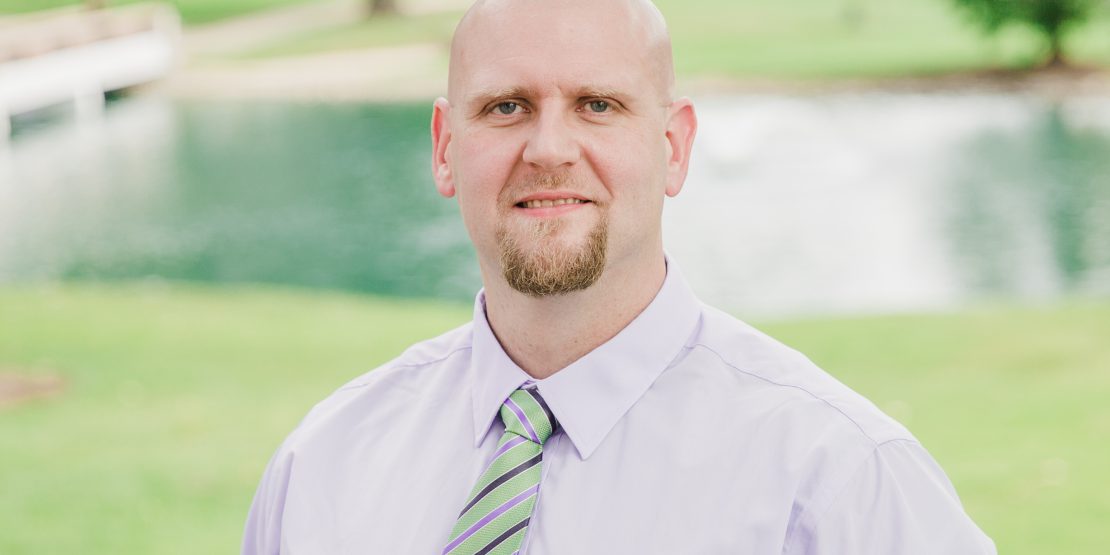Steve Middleton
Assistant Professor in Athletic Training; Director of the Athletic Training Program
Expertise: Athletic Training, Sports Medicine, Rehabilitation, and Manual Therapy
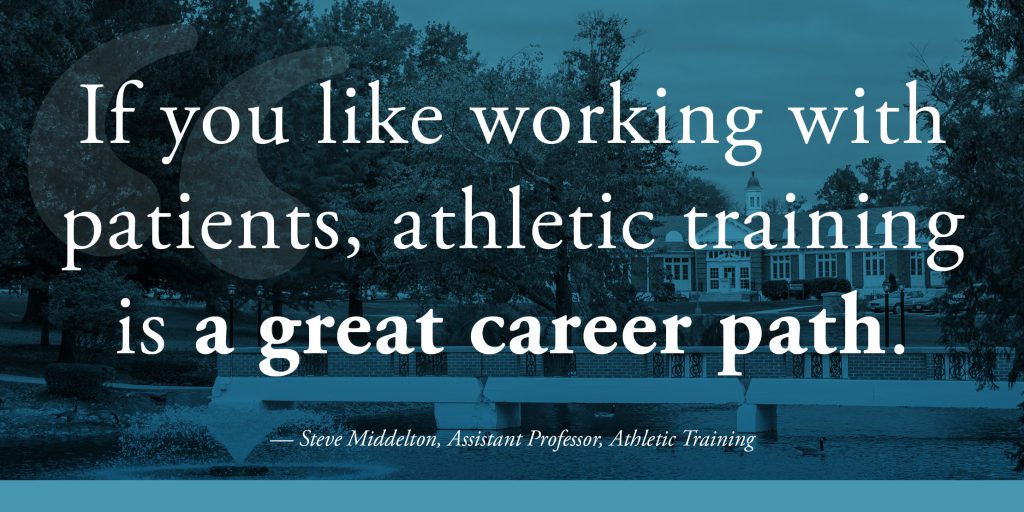
From Theatre to Athletic Training
I became interested in athletic training how I think most get into this field: I got injured. I was weight lifting when I was in college and hurt my shoulder.
At the time, I was actually a dual major in English literature and theatre — pretty far from the medical and sports fields. But I could tell that I had to work too hard at it and I wasn’t as successful as I wanted to be. This wasn’t my path.
I didn’t know what athletic training was back then. I grew up in a small town in Illinois, and I didn’t really have exposure to other health care fields until I moved to a larger city. The more I got into it and started working with patients and active populations, the more I knew it was the right field for me. Looking back, I was always interested in Leonardo da Vinci’s work on anatomy. It fits very much into what I’m doing now.
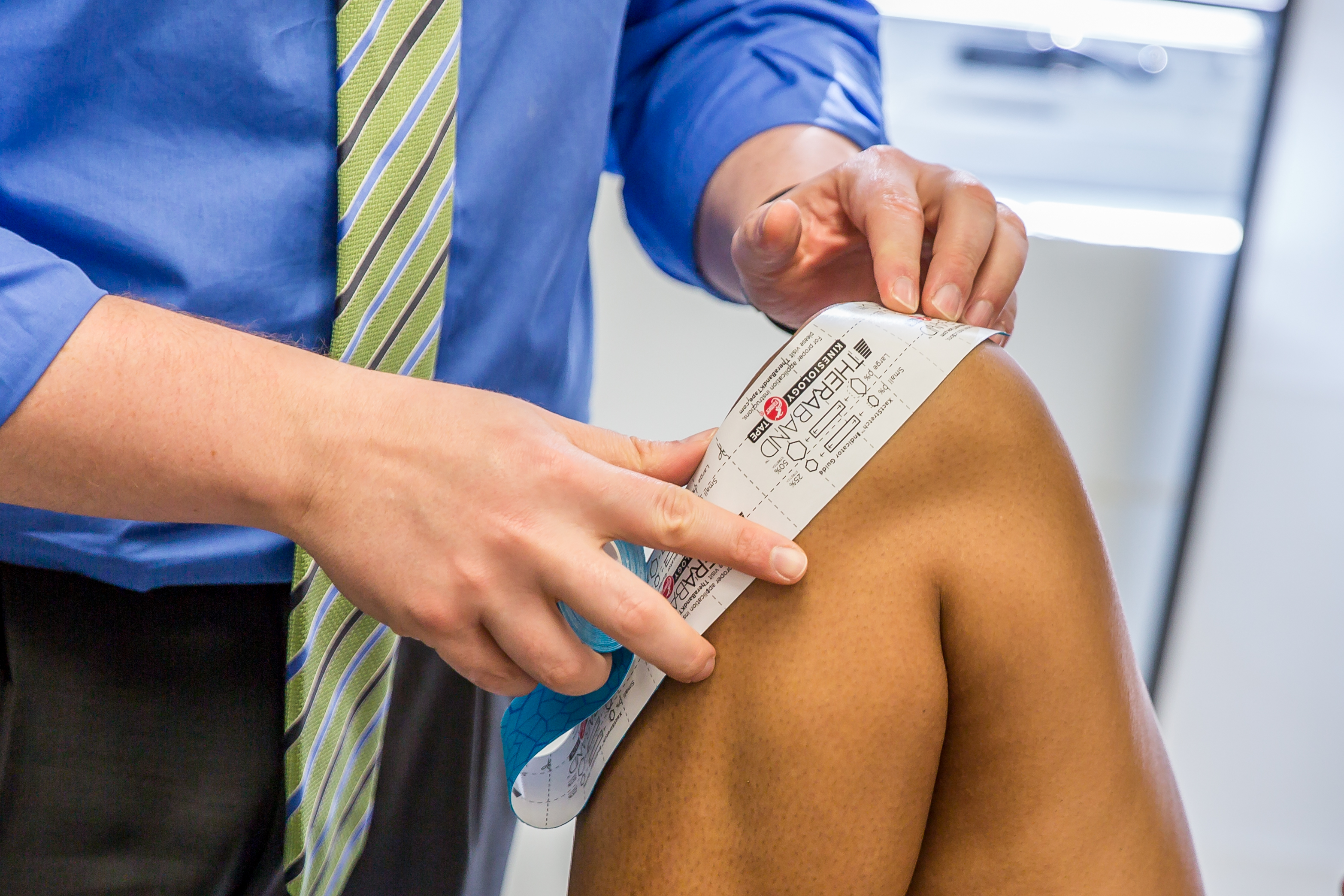
I graduated college with a degree in athletic training and followed up with a master’s in exercise science and health promotion. From there, I knew I wanted to teach at the university level, so I needed to go into a doctoral program, but I didn’t want to just research — I wanted something that would expand my clinical skills as well. So, I went for a doctorate in physical therapy, which opened up more areas of interest for me. For example, I can now perform dry needling (a needle-based therapy for muscle pain that is allowed in certain states) and incorporate other new, emerging techniques into the William Woods program.
The more techniques our athletic training students are aware of, the better they can relate to their future patients.
Athletic Training Research
I’m also very interested in research within this field. I have published one research study and one case study on pelvic pain. I’m also working on another data collection portion of a research study, looking at different causes of pelvic pain, primarily at sacroiliac joint dysfunction.
Research is important, as it is what separates a profession from a trade; research is also designed to expand our profession by building upon our knowledge of the human body and our techniques. With rising health care costs, all medical professions are moving towards evidence-based practice, which looks at the research behind our interventions, while also taking into consideration our clinical experience as well as the patient’s expectations. It is important for our students to be active consumers of research where they are able to not only read the available research, but also critically appraise it to determine how to best implement that information into their clinical practice upon graduation.
By the time our athletic training majors graduate from William Woods, they have been exposed to a minimum of 100 peer-reviewed research articles.
As we expand our program, there will be more opportunities for our majors to not only participate in research, but to complete some of their own.
Sports Studies Offerings
Here at William Woods, there are many different paths that students can take within sports studies. We all work together, but with different focuses.
In physical education, you teach people how to be active and may want a career as a P.E. teacher or coach. Exercise science is more about performance and the conditioning aspect of the body, with many students going on to careers in personal training or working as professional strength coaches. Sports management offers a business focus on overseeing facilities, with scheduling, hiring support staff, etc. In athletic training, we focus on the prevention and care of injuries, including rehabilitation.
Students going into sports studies often take classes in each of these disciplines before breaking off into a specific area.
Careers in Athletic Training
Athletic trainers are a combination EMT, physician’s assistant, physical therapist, dietician, psychologist, etc.
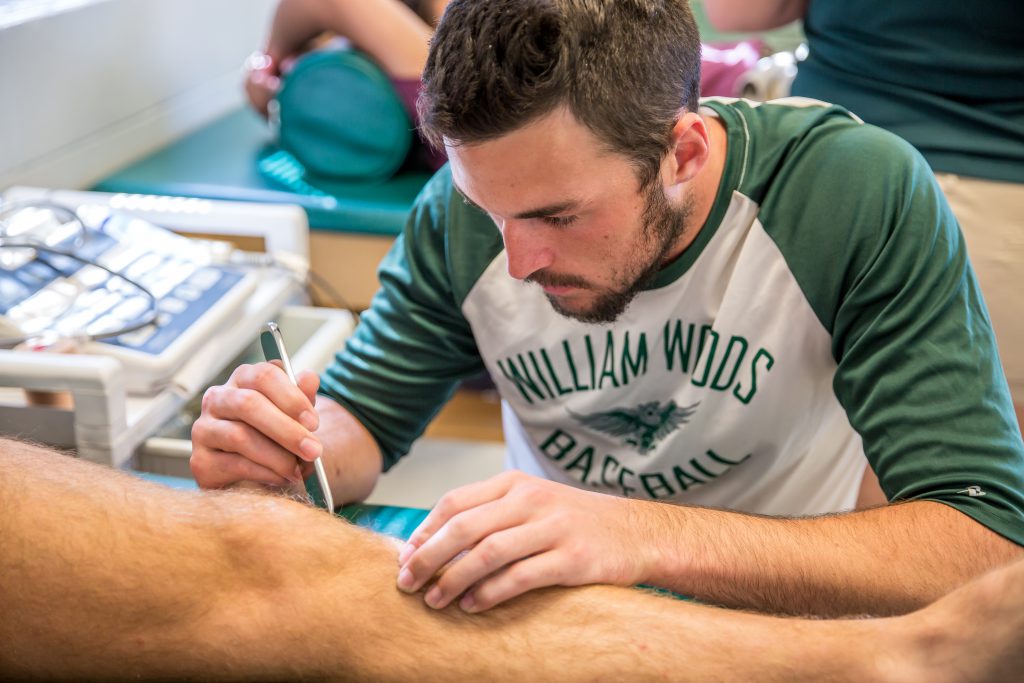
A lot of people don’t understand what athletic trainers do. Even students wanting to come into the program aren’t really always sure. When people hear the term “athletic training”, they think we only treat athletes and make work-out plans.
People in this field actually have careers in a variety of settings. We can work in the traditional settings with high school students, college athletes, and professional sports. There are also emerging fields of practice, such as industrial medicine in large companies and factories, where they may offer an on-site rehab clinic to address injuries in the workplace. Many athletic trainers also work with performers and dancers. Walt Disney World is actually a big employer of athletic trainers, hiring them to help with their workers and cast members; one of our 2017 graduates is currently completing an internship at Disney’s Wide World of Sports complex. Others may want more traditional 9–5 schedules and work as an athletic trainer in a physician’s office, where they assist with patient care (such as taking a history and performing an exam) and patient management (such as scheduling imaging or coordinating referrals).
If you like working with patients, athletic training is a great career path. A physician or physician’s assistant may only see a patient for ten minutes every few months or even every year. With athletic training, you focus on the patient and really get to know him or her. You spend a minimum of a half an hour with them three to four times a week in outpatient settings; in high school and college settings, you may see them every day. You may learn more about their body than they know, picking up on problems that they haven’t even recognized yet and before they become an injury. This field is about preventing injuries. Your goal is to realize something is not quite right with the person and address it before it becomes a major problem.
There are many different certifications you can attach to your degree to specialize your career. Depending on the person’s interests, there are certifications relevant to conditioning (CSCS – Certified Strength and Conditioning Specialist through the National Strength and Conditioning Association), performance (PES – Performance Enhancement Specialist through the National Academy of Sports Medicine), or concussions.
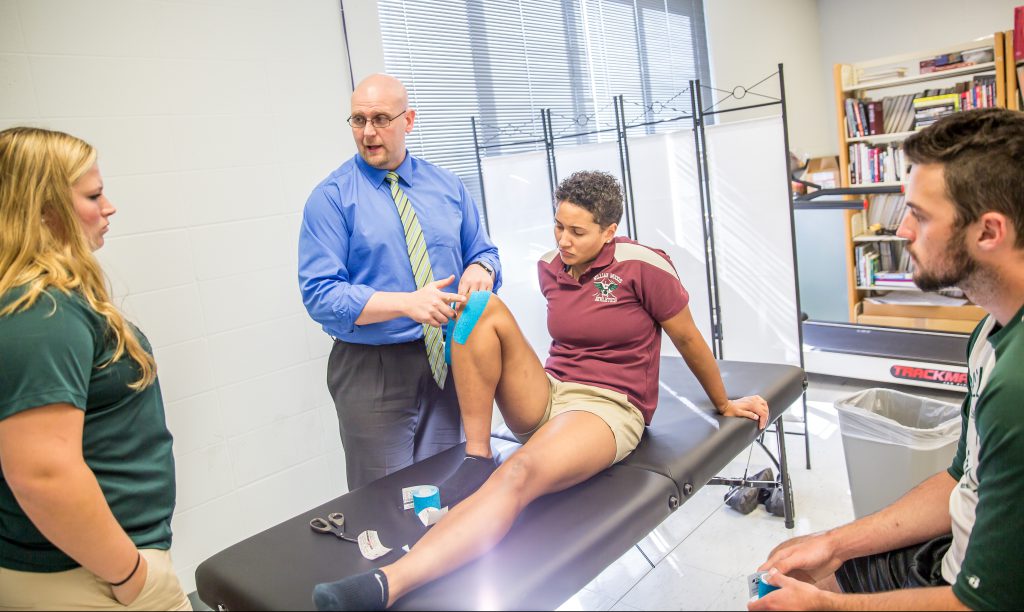
I’m personally certified in Graston Technique, a type of instrument-assisted soft tissue manipulation that is similar to massage but with faster results. I’m also a Certified Kinesio Taping Practitioner that is vastly different than the traditional white athletic tape that most people are used to having. William Woods is proud to be the only athletic training program in the country to offer these advanced skills as part of our entry-level curriculum.
The New Athletic Training Graduate Program
In order to help set up our students for success, we are starting a new athletic training graduate program. Students will now graduate in five years with a bachelor of science in exercise science with a sports medicine concentration and a master of science in athletic training. They will take three years of undergraduate coursework, use their senior year for dual undergraduate and graduate credit, and follow with a fifth year of all practical work. We are also expanding the number of courses students take in anatomy, biology, chemistry, and physiology. The more exposure they get to these topics, the more successful they are going to be in our program and their careers.
We can also now accept transfer students more easily. People can complete their bachelor’s degree at another school and come here just for their master’s in athletic training, which takes two years.
The athletic training field is starting to expand the levels of education needed. It used to be a bachelor’s degree was sufficient and now a master’s degree is required for most positions. There is also a growing trend in doctor of athletic training programs. We want to give our students the advanced skills they need for this discipline.
Becoming an Athletic Training Major
One of the best things about the William Woods athletic training program is the attention students receive. At other institutions, I’ve been in classes with over 150 people. Here, professors get to know the students and interact with them on a one-on-one basis. A lot of athletic trainers aren’t taught hands-on treatments, but our classes are very hands-on. We even cap some classes at ten students, because they are so involved.
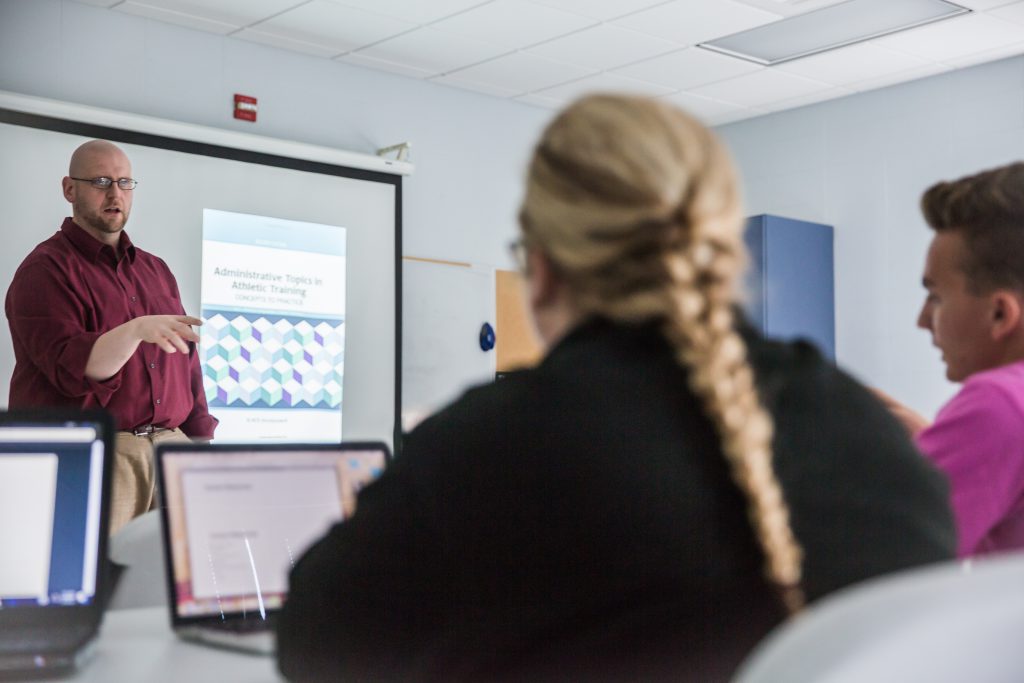
When you first come to William Woods as a freshman, we focus on introducing you to the topic gradually. One of the first classes you take is Introduction to Anatomy, where you learn about all of the body parts because all of your other classes will build on this information. Then, in the spring semester, you’ll take Introduction to Physiology and learn how those body parts function and how the organs work. In your sophomore year, students get more into the exercise science-specific courses, taking Kinesiology (how the muscles work) and Exercise Physiology (how the heart, lungs, and the other organs work during physical activity). Students also take basic sciences their first three years, including biology, chemistry, and physics.
The spring semester of junior year is when students formally apply to the athletic training program. We want our majors to be aware of what the profession involves before they commit. Before applying, they need to complete 50 observational hours with a certified athletic trainer in our athletics department or one of our other clinical affiliations. They get to see what the job actually entails, if it’s what they thought it was, and if they want to continue with the program. If students decide athletic training isn’t for them, they can change their major (we’ve reworked the exercise science curriculum to make it easy to switch). This process is better than being halfway through the major and realizing this career isn’t a good fit.
If they want to move forward with athletic training, students submit a formal application, including a one-page essay on why they want to join the profession. We look at their GPA and ACT scores and bring them in for a formal interview with our faculty, clinical instructors, and a current athletic training student.
Athletic Training Classes
One of the first Athletic Training classes students take is Prevention and Care of Athletic Injuries. There is a lot of information to cover in our athletic training classes, so we use a three-pronged approach. Classes usually have a lecture component, so that students get the rationale behind why we do what we do. We also incorporate a lab component, where students take that rationale and put it into practice by performing different examination techniques, manual therapy interventions and therapeutic exercises on one another. It’s important that our students know how to perform the techniques and that they also know what it should feel like so they can better explain it to future patients. The third component is the clinical phase, where students actually treat real patients and apply the techniques they’ve learned to reinforce and develop hands-on skills.
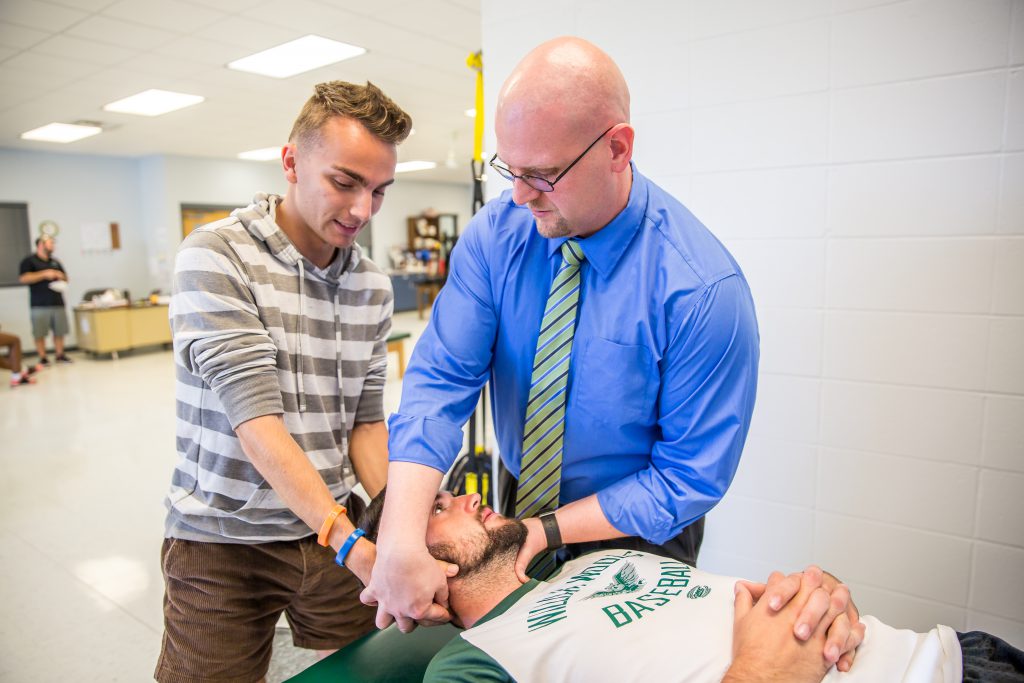
By the time students start their senior year, which is the dual credit year that also counts towards their master’s degree, they’ve learned the basics. Senior year is when we go deeper into anatomy with three examination courses: Lumbar Spine and Lower Extremity, Cervical Spine and Upper Extremity, and General Medical Conditions. Students will learn how to determine what’s normal tissue versus what’s dysfunctional tissue and how to use different devices (such as electrical stimulation and ultrasound) to alleviate pain and will take a general medical course.
Once they’ve learned how to evaluate, they start learning more treatments. They’ll take a Manual Therapy course, where they learn posture evaluation, myofascial manipulation, joint manipulation, Graston Technique, and kinesiology taping.
Hands-On Athletic Training
This hands-on component is important throughout all of our courses. We also do regular practical examinations during class to give them more experience. Each student picks a realistic case scenario and has to figure out how to handle it with me or a classmate as the patient. I may say “I have shoulder pain”, which could be anything from a torn rotator cuff to a dislocation. The students only get the information that they ask about and their questions may lead them down different paths. It’s the athletic training version of a choose-your-own-adventure book.
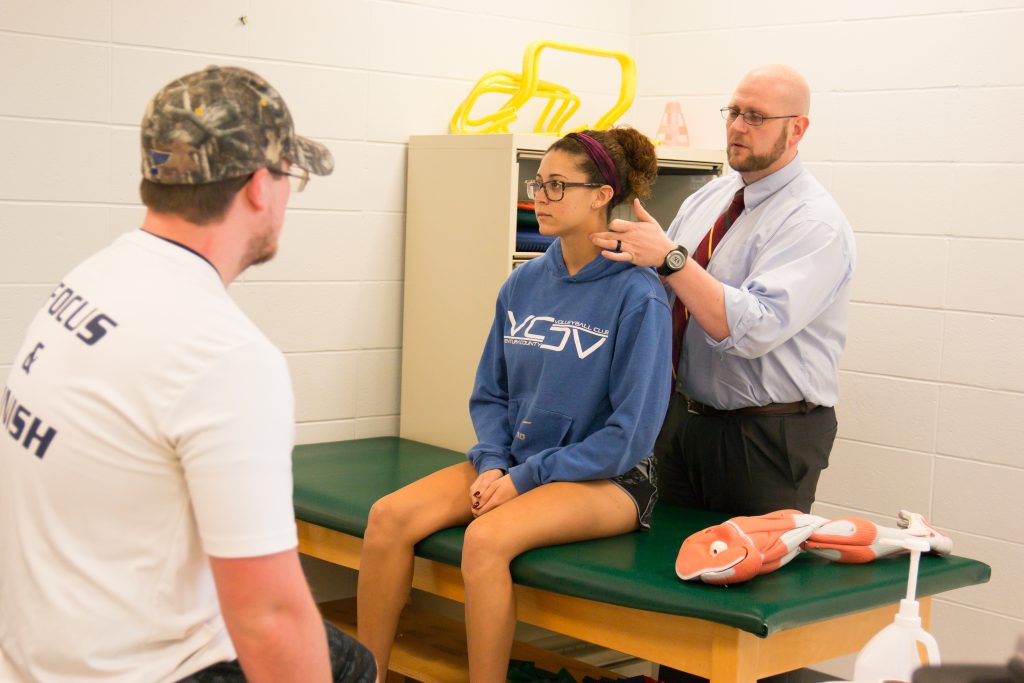
In a therapeutic exercise class, we incorporate a lot of post-surgical treatments, so I once came into the room on crutches with a bandage around my knee. The student doing the practical just stood there and stared at me in surprise for about 30 seconds before starting the evaluation. But once they get past that “uh-oh” moment, they all do really, really well. I’m very pleased with how our students progress as clinicians throughout the program.
In order to promote hands-on training, we also have an athletic training clinic on campus. Students, faculty, and staff at the university can come into the free clinic to work with our students (under my supervision). It gives our majors great experience.
Clinical Athletic Training
Year five continues that theme of hands-on training. It’s the time for fine-tuning things and actually going out and treating real patients. We’ve worked to refine students’ clinical experiences so they get a wide variety of exposure. They will work in four different scenarios over the course of the program:
- a local college’s football team for an equipment intensive clinical
- a high school, functioning as athletic trainers by performing evaluations, treatments, and emergency care under the supervision of the school’s certified and licensed athletic trainer
- an outpatient physical therapy clinic
- a physician’s office, working with general medical conditions, screening for different illnesses, looking at how they manage them, looking at the pharmacology and drug interactions, etc.
Our students tend to be overachievers and definitely make the most of their college experience. During their four clinical courses, they’re completing at least 800 hours of clinical time — in addition to other classes and extracurricular activities. Many of the students in our program also play on university sports teams. Some worry that they won’t be able to juggle both the academic and athletic programs but we work with students to manage their schedules. And they get it all done.
Final Case Studies and Exams
Their last semester is the culmination of everything. Students present a case study, which can prompt a larger scale research study. They identify an athletic training injury they have personally treated that is unique and figure out why it’s unique. It could be an unusual injury or treatment approach to a more common injury. One of our students recently presented on someone with a brain tumor. Typically, a brain tumor in this particular location will affect balance and coordination, but the patient, who was a student-athlete from Brazil, didn’t have any symptoms other than a headache. The senior had to coordinate with multiple countries to get medical reports to complete her study. It was our program’s first international case study.
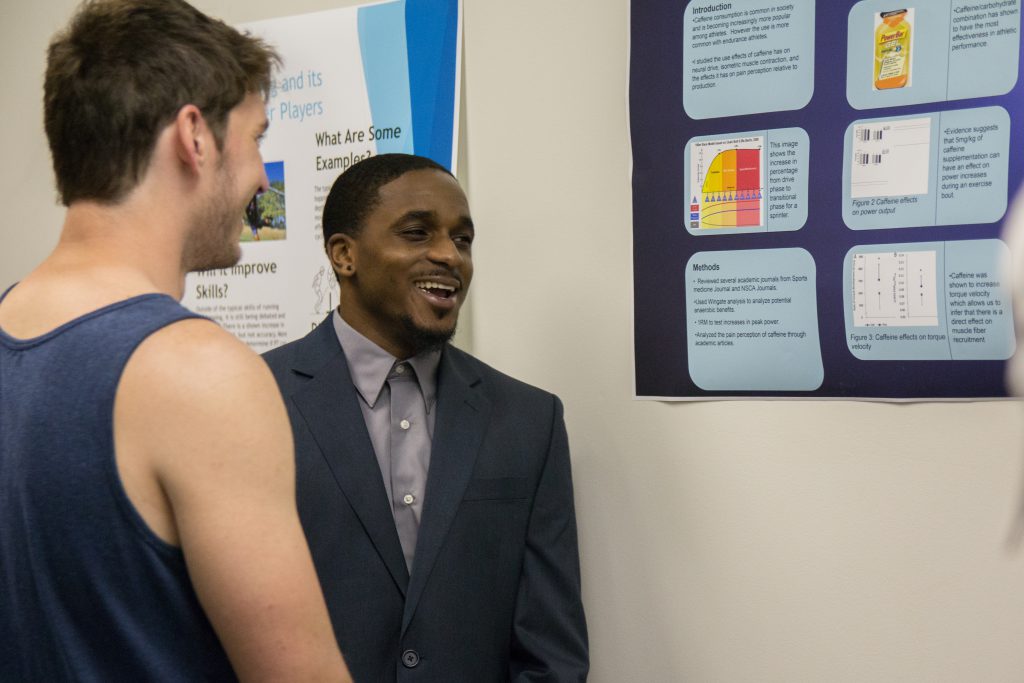
Students will present their research in three fashions: a written document that they submit to peer review journals, an oral presentation during a campus event for National Athletic Training Month in March, and a poster presentation during a campus event.
Before graduating, students will also have to pass a board of certification exit exam and a practical case scenario exam.
Why Choose Athletic Training
Athletic training is the perfect major for those that want to enter the medical field and help people with being able to perform daily activities. While athletic trainers still thrive in the traditional settings of high school, college, and professional sports, the population has driven the need for our services elsewhere as well. Athletic trainers work with treating all active individuals — be it athletes to factory workers to weekend warriors to the military. If you are looking for a career and profession where you can have a drastic impact on someone’s life, while also having the job flexibility to live your own, I can’t think of a better major than athletic training.
| Learn more about the William Woods Athletic Training program |

